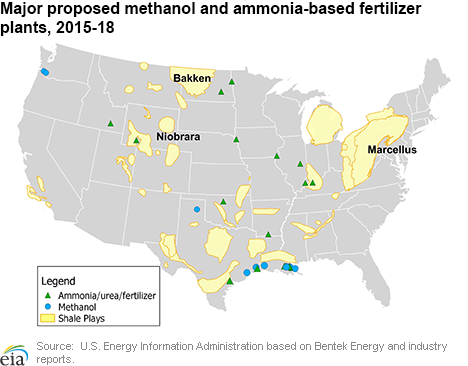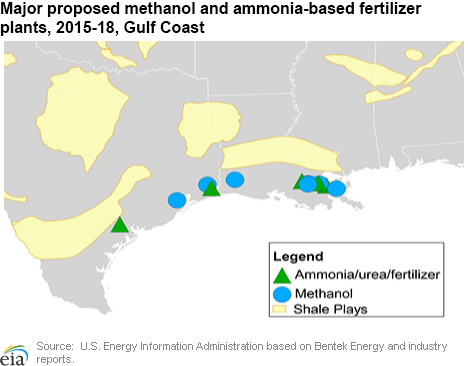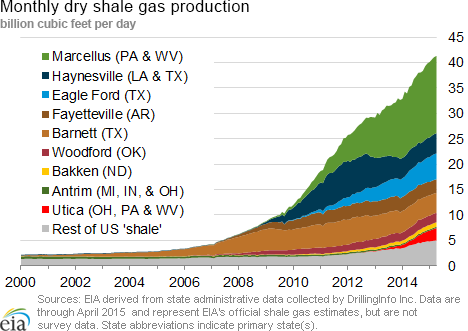In the News:
New chemical plants expected to boost industrial natural gas use by 4% in 2015
Several new energy-intensive industrial facilities started service in 2015, and there are additional projects scheduled to come online in the next year. Industrial natural gas consumption has grown steadily since 2009, as relatively low natural gas prices have been attractive to customers who use natural gas as a feedstock for chemical production. Methanol plants and ammonia- or urea-based fertilizer plants are among the most natural gas-intensive industrial end users, with many using 100 million cubic feet per day (MMcf/d) or more. In the Short-Term Energy Outlook, EIA forecasts that these new projects will help drive growth in industrial natural gas demand through the forecast period, which runs through the end of 2016. EIA forecasts consumption will average 21.8 billion cubic feet per day (Bcf/d) in 2015 and 22.4 Bcf/d in 2016. That industrial consumption in 2016 is expected to be 5.5 Bcf/d, or 33%, greater than in 2009.
Industrial demand for natural gas has been relatively high in the Gulf Coast, and several of the new projects are located there. Two methanol plants began service this year – a small facility in Pampa, Texas, and one in Geismar, Louisiana, and a larger methanol facility is planned to come online later this year in Clear Lake, Texas. Additionally, a handful of fertilizer plants have also begun service, and an expansion is planned at a plant near Beaumont, Texas, later this year.
While most of the proposed methanol plants are on the Gulf Coast, two are proposed for 2018 in the Pacific Northwest. Northwest Innovation Works, a multinational company that includes the Chinese Academy of Science and British Petroleum, is planning two methanol facilities on the Columbia River in Washington and Oregon. The company plans to export methanol produced in the United States to markets in China.
Proximity to shale development in the Marcellus, Utica, Bakken, and Niobrara areas have led to proposals for facilities outside of Texas and Louisiana.
Later this year, a relatively large fertilizer/urea plant in Wever, Iowa, is planned to come online, and will support continued growth in industrial demand. Additionally, two fertilizer plants are planned for towns less than 75 miles away in southern Indiana: Ohio Valley Resources has proposed a fertilizer plant for Rockport, Indiana, for 2017, and Fatima Resources has proposed one for Mount Vernon, Indiana, for 2018. Each of these would use close to 90 MMcf/d.
Developers also hope to take advantage of abundant natural gas in the Bakken Shale. Two ammonia-based fertilizer plants are proposed for North Dakota for 2018. Farm-owned cooperative CHS Inc.'s proposed plant in Spiritwood and Northern Plains Nitrogen's proposed plant for Grand Forks are both in permitting stages. Both have expected production of 2,400 tons of ammonia per day and would use close to 100 MMcf/d of natural gas each, according to Bentek Energy estimates.
While most natural gas-intensive projects are in the fertilizer or methanol sector, a primary metals facility manufacturing iron ore pellets is planned to open in Itasca, Minnesota, at the end of this year. The facility, which will be operated by Essar Steel Minnesota, will use an estimated 115 MMcf/d, according to Bentek Energy.
Overview:
(For the Week Ending Wednesday, May 20, 2015)
- Prices of natural gas at most market locations rose over the report week (Wednesday, May 13 –Wednesday, May 20), while still remaining relatively low. The Henry Hub spot price began the week at $2.86 per million British thermal units (MMBtu) last Wednesday and ended the week at $2.99/MMBtu.
- At the New York Mercantile Exchange (Nymex), the near-month contract (June 2015) fell slightly, from $2.935/MMBtu last Wednesday to $2.915/MMBtu yesterday.
- Working natural gas in storage increased to 1,989 Bcf as of Friday, May 15, according to the U.S. Energy Information Administration (EIA) Weekly Natural Gas Storage Report (WNGSR). A net injection into storage of 92 Bcf for the week resulted in storage levels 59.0% above year-ago levels and 1.7% below the five-year average for this week.
- The total oil and natural gas rig count fell by 6 units to 888 as of Friday, May 15, according to data from Baker Hughes Inc. The oil rig count fell by 8 units to 660, and the natural gas rig count rose by 2 units to 223.
- The natural gas plant liquids composite price fell by 10¢ per MMBtu to $5.42/MMBtu for the week ending May 15. Natural gasoline remained flat, while ethane prices rose 4.4%. All of the other Mont Belvieu liquids prices fell this week. Propane, butane, and isobutane fell by 5.3%, 2.9%, and 2.5%, respectively.
Prices/Demand/Supply:
Prices rise again. Prices at most market locations outside of the Northeast rose slightly this week, the third consecutive week of increases. The Henry Hub spot price began the week at $2.86/MMBtu and settled yesterday at $2.99/MMBtu. During the week, Henry Hub prices rose above $3/MMBtu for the first time since early March. Prices at other major trading hubs moved in a similar pattern; prices at the PG&E Citygate rose from $3.20/MMBtu last Wednesday to $3.34/MMBtu yesterday. Chicago prices rose from $2.87/MMBtu last Wednesday to $3.01/MMBtu yesterday.
Weather is mild with some hot days. Temperatures this week were relatively mild, though there were a few hot days. Across much of the South, Midwest, and Northeast, high temperatures on Monday and Tuesday were in the 80s, before cooling on Wednesday. While prices rose this week, they still remained relatively low, with prices settling Wednesday at less than $3/MMBtu at most market locations. Last year at this time, Henry Hub spot prices were around $1.50/MMBtu greater than their current levels; on May 20, 2014, Henry Hub spot prices were $4.52/MMBtu. EIA's Short-Term Energy Outlook expects prices to rise somewhat through the summer as demand for air-conditioning picks up, but still remain relatively low.
Northeast prices decline in major market areas. At Transcontinental Pipeline's Zone 6 delivery point serving New York City, prices began the week at $2.86/MMBtu and ended the week down 27¢ at $2.59/MMBtu. At the Algonquin Citygate, which serves Boston consumers, prices fell from $1.91/MMBtu at the beginning of the week to $1.81/MMBtu yesterday. Transco Zone 6 prices remain very low, but they are higher relative to the Henry Hub benchmark prices than they were last year. For much of May, Transco Zone 6 prices have been at a slight premium to Henry Hub prices – in May 2014, Transco Zone 6 prices averaged almost $1 less than the Henry Hub price. Various maintenance events in the Northeast have put upward pressure on prices – Transco Zone 6 could see prices fall as maintenance wraps up, according to Bentek Energy analysis.
Marcellus prices rise. Marcellus-area prices were mixed through the week, but most trading points posted an overall increase. At Tennessee's Zone 4 Marcellus location, prices rose from $1.32/MMBtu last week to $1.40/MMBtu yesterday. On the Transco Leidy Line, prices rose from $1.43/MMBtu last week to $1.56/MMBtu yesterday, but reached $1.64/MMBtu on Tuesday. At Dominion South, which serves customers in portions of Pennsylvania, Ohio, Maryland, West Virginia, and Virginia, prices rose from $1.52/MMBtu to $1.59/MMBtu.
Nymex prices fall. Unlike spot prices, Nymex prices declined this week. The June 2015 contract fell from $2.935/MMBtu last Wednesday to $2.915/MMBtu yesterday. The 12-month strip (the average of the 12 contracts between June 2015 and May 2016) fell from $3.148/MMBtu last Wednesday to $3.120/MMBtu yesterday.
Maintenance events slow production. Production this week fell by 0.2%, according to Bentek Energy data, but is still 7.1% greater than last year's levels. This week, Enable Gas performed maintenance on its Carthage, Texas, to Perryville, Louisiana, pipeline. The company announced maintenance was completed today. Additionally, Destin Pipeline announced it will continue performing maintenance through June 2 and that its Mississippi Offshore facilities remain shut in. Imports of natural gas from Canada rose 2.9%, while LNG sendout increased but remained at minimal levels. Overall, supply was flat week over week.
Demand declines. U.S. consumption fell by 2.9% this week, with the largest decline in the power sector. Consumption of natural gas for power generation (power burn) fell 6.8% week over week, but was 22.3% greater than the same time last year. Residential and commercial consumption fell 1.2% week over week, and industrial consumption rose 0.9% from last week. Exports to Mexico declined by 0.7% from last week.
Storage
Net storage injection is larger than the five-year average build but lower than last year. The net injection reported for the week ending May 15 was 92 Bcf, down from 111 Bcf the previous week. This level compares with the five-year average net increase of 89 Bcf for that week and last year's net increase of 106 Bcf. Working gas inventories for the storage week totaled 1,989 Bcf, 738 Bcf (59.0%) higher than last year at this time and 35 Bcf (1.7%) lower than the five-year (2010-14) average.
Storage injections are lower than market expectations. Market expectations, on average, called for a build of 97 Bcf. When the EIA storage report was released at 10:30 a.m. on May 21, the price for the June natural gas futures contract increased 6¢ to $3.02/MMBtu in trading on the Nymex, and decreased 4¢ to $2.98 a few minutes later. In the next hour, prices oscillated between $2.97 and $3.01.
From the week ending April 3 (the beginning of the injection season) through the week ending May 15, net storage injections totaled 528 Bcf, or 26% more than the 418 Bcf injected during the same seven weeks in 2014. During these weeks between 2010 and 2014, on average, net injection into storage totaled 373 Bcf. The estimated average unit value of the natural gas storage holders put into storage from April 3 to May 15 this year was $2.68/MMBtu, 42% lower than the average value of $4.66/MMBtu for the same seven weeks last year. The highest winter-month Nymex price (for the January 2016 contract) in trading for the week ending May 15 averaged $3.38/MMBtu. This price is 46¢/MMBtu more than the June Nymex contract price. A year ago, the difference was 18¢/MMBtu, suggesting there is more financial incentive this year to buy and store natural gas in the summer for sale in the winter.
There are currently 24 more weeks in the injection season, which traditionally runs from April 1 through October 31, although in many years injections continue into November. EIA forecasts that the end-of-October working natural gas inventory level will be 3,890 Bcf, which, as of May 15, would require an average injection of 79 Bcf per week through the end of October. EIA's forecast for the end-of-October inventory level is above the five-year (2010-14) average peak storage value of 3,813 Bcf. To reach the five-year average peak value, average weekly injections through the end of October would need to be 76 Bcf.
All three regions report net injections for the week. Net injections for the week in the East were 55 Bcf (4 Bcf larger than its five-year average injection). They were 6 Bcf (7 Bcf smaller than its five-year average) in the West and 31 Bcf (5 Bcf larger than its five-year average) in the Producing region. The East region's inventory is below its five-year average by 146 Bcf (16.4%). In contrast, stock levels in the West and Producing regions are above their five-year averages for the week, by 61 Bcf (19.0%) and 50 Bcf (6.1%), respectively. Storage levels for the East, West, and Producing regions are above their year-ago levels by 229 Bcf, 153 Bcf, and 356 Bcf, respectively.
Temperatures during the storage report week are warmer than normal. Temperatures in the Lower 48 states averaged 63.6° for the storage report week, 2.9° warmer than the 30-year normal temperature and 1.7° cooler than the average temperature during the same week last year. There were 38 population-weighted heating degree days (HDD) during the storage report week, 2 HDD more than the five-year average and 10 HDD more than during the same period last year. There were also 28 population-weighted cooling degree days (CDD) this report week, 6 CDD more than the five-year average and 2 CDD fewer than during this week last year.
See also:
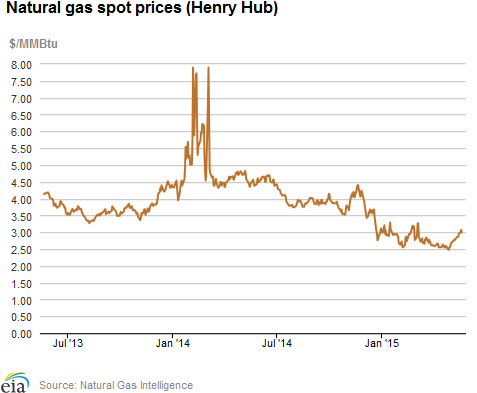
| Spot Prices ($/MMBtu) | Thu, 14-May |
Fri, 15-May |
Mon, 18-May |
Tue, 19-May |
Wed, 20-May |
|---|---|---|---|---|---|
| Henry Hub |
2.87 |
2.96 |
3.01 |
3.07 |
2.99 |
| New York |
2.61 |
2.62 |
3.10 |
3.11 |
2.59 |
| Chicago |
2.87 |
2.93 |
3.05 |
3.13 |
3.01 |
| Cal. Comp. Avg,* |
2.92 |
2.95 |
3.04 |
3.10 |
3.01 |
| Futures ($/MMBtu) | |||||
| June contract |
3.008 |
3.016 |
3.010 |
2.948 |
2.915 |
| July contract |
3.063 |
3.070 |
3.061 |
2.991 |
2.959 |
| *Avg. of NGI's reported prices for: Malin, PG&E citygate, and Southern California Border Avg. | |||||
| Source: NGI's Daily Gas Price Index | |||||
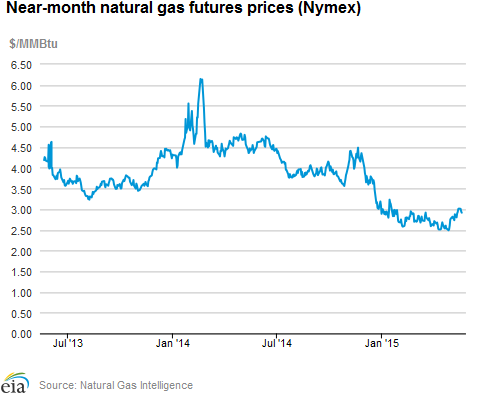
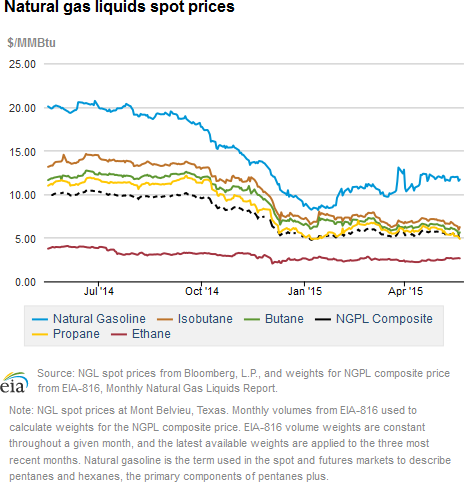
| U.S. natural gas supply - Gas Week: (5/13/15 - 5/20/15) | ||
|---|---|---|
Percent change for week compared with: |
||
last year |
last week |
|
| Gross production | 7.16%
|
-0.22%
|
| Dry production | 7.10%
|
-0.22%
|
| Canadian imports | 2.96%
|
2.87%
|
| West (net) | 28.81%
|
0.93%
|
| Midwest (net) | -12.71%
|
11.27%
|
| Northeast (net) | 133.49%
|
86.28%
|
| LNG imports | -12.69%
|
108.93%
|
| Total supply | 6.78%
|
0.04%
|
| Source: BENTEK Energy LLC | ||
| U.S. consumption - Gas Week: (5/13/15 - 5/20/15) | ||
|---|---|---|
Percent change for week compared with: |
||
last year |
last week |
|
| U.S. consumption | 4.0%
|
-2.9%
|
| Power | 22.3%
|
-6.8%
|
| Industrial | -2.5%
|
0.9%
|
| Residential/commercial | -9.8%
|
-1.2%
|
| Total demand | 5.0%
|
-2.8%
|
| Source: BENTEK Energy LLC | ||
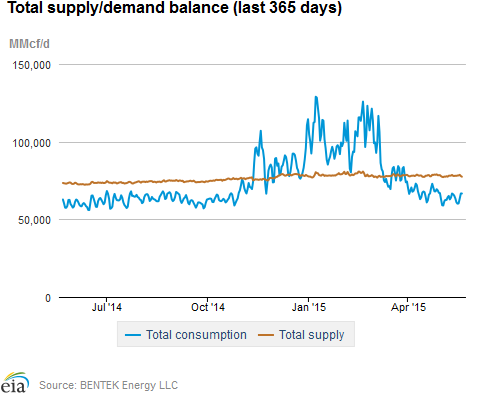
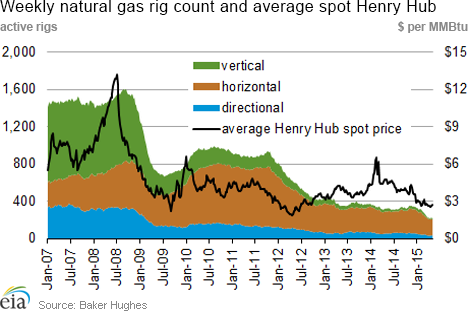
| Rigs | |||
|---|---|---|---|
Fri, May 15, 2015 |
Change from |
||
last week |
last year |
||
| Oil rigs | 660 |
-1.20% |
-56.89% |
| Natural gas rigs | 223 |
0.90% |
-31.60% |
| Miscellaneous | 5 |
0.00% |
25.00% |
| Rig numbers by type | |||
|---|---|---|---|
Fri, May 15, 2015 |
Change from |
||
last week |
last year |
||
| Vertical | 114 |
0.00% |
-71.92% |
| Horizontal | 685 |
-1.01% |
-45.11% |
| Directional | 89 |
1.14% |
-57.00% |
| Source: Baker Hughes Inc. | |||
| Working gas in underground storage | ||||
|---|---|---|---|---|
Stocks billion cubic feet (bcf) |
||||
| Region | 2015-05-15 |
2015-05-08 |
change |
|
| East | 742 |
687 |
55 |
|
| West | 382 |
376 |
6 |
|
| Producing | 865 |
834 |
31 |
|
| Total | 1,989 |
1,897 |
92 |
|
| Source: U.S. Energy Information Administration | ||||
| Working gas in underground storage | |||||
|---|---|---|---|---|---|
Historical comparisons |
|||||
Year ago (5/15/14) |
5-year average (2010-2014) |
||||
| Region | Stocks (Bcf) |
% change |
Stocks (Bcf) |
% change |
|
| East | 513 |
44.6 |
888 |
-16.4 |
|
| West | 229 |
66.8 |
321 |
19.0 |
|
| Producing | 509 |
69.9 |
815 |
6.1 |
|
| Total | 1,251 |
59.0 |
2,024 |
-1.7 |
|
| Source: U.S. Energy Information Administration | |||||
| Temperature -- heating & cooling degree days (week ending May 14) | ||||||||
|---|---|---|---|---|---|---|---|---|
HDD deviation from: |
CDD deviation from: |
|||||||
| Region | HDD Current |
normal |
last year |
CDD Current |
normal |
last year |
||
| New England | 26
|
-45
|
-20
|
13
|
13
|
9
|
||
| Middle Atlantic | 18
|
-39
|
-1
|
24
|
22
|
18
|
||
| E N Central | 48
|
-15
|
25
|
14
|
6
|
-5
|
||
| W N Central | 72
|
18
|
10
|
2
|
-7
|
-11
|
||
| South Atlantic | 5
|
-18
|
4
|
65
|
31
|
-2
|
||
| E S Central | 5
|
-16
|
4
|
50
|
26
|
-4
|
||
| W S Central | 7
|
2
|
-3
|
56
|
7
|
-2
|
||
| Mountain | 82
|
14
|
-15
|
8
|
-8
|
-2
|
||
| Pacific | 55
|
12
|
28
|
0
|
-6
|
-14
|
||
| United States | 38
|
-9
|
10
|
28
|
11
|
-2
|
||
|
Note: HDD = heating degree-day; CDD = cooling degree-day Source: National Oceanic and Atmospheric Administration | ||||||||
Average temperature (°F)
7-Day Mean ending May 14, 2015
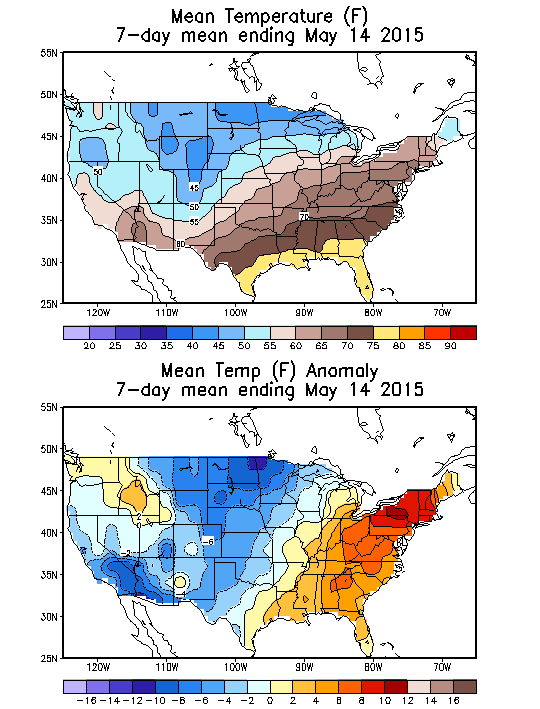
Source: NOAA/National Weather Service
Deviation between average and normal (°F)
7-Day Mean ending May 14, 2015

Source: NOAA/National Weather Service

